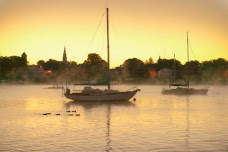 What happened to April showers?
What happened to April showers?The weather has been perfectly beautiful — and perfectly dry — ever since Retired Guy and I got back from our tropical vacation two weeks ago. So yesterday, in between bouts of playing catch-up watering the yard, we found ourselves in Bristol looking at kayaks at Northwind Sports.
Actually, we had driven to Bristol for another reason altogether, which was to pick up our Osprey license plates from the Audubon Society Environmental Education Center, where they were being distributed to the 1,200 folks like us who signed up for a first edition of these pretty plates, which cost $40, with half going to support the education efforts of Audubon and Save The Bay. The Osprey, or fishing hawk, is a native species, and like other coastal natives such as plovers, it needs human help to survive. In the case of the Osprey, the chemical DDT is thought to have been the cause of a decline that caused the bird to be protected under the Endangered Species Act three decades ago. It has since returned in increasing numbers.
 Many bird-lovers don't realize that other native species of birds such as bluebirds, cardinals, swallows and chickadees are endangered by rapidly multiplying populations of the non-native invasive species House Sparrow, which take over the nests of native birds and kill their chicks. The Audubon Society educates people about how to deter aggressive invasive species like the sparrow and instead help native species of birds to survive. (Monitor bird houses to be sure sparrows aren't nesting in them, and feed only seeds such as sunflower and thistle that don't attract sparrows.)
Many bird-lovers don't realize that other native species of birds such as bluebirds, cardinals, swallows and chickadees are endangered by rapidly multiplying populations of the non-native invasive species House Sparrow, which take over the nests of native birds and kill their chicks. The Audubon Society educates people about how to deter aggressive invasive species like the sparrow and instead help native species of birds to survive. (Monitor bird houses to be sure sparrows aren't nesting in them, and feed only seeds such as sunflower and thistle that don't attract sparrows.)So there we were in Bristol, with our new Osprey plates on the car and the harbor glistening behind Thames Street Landing, which is where Northwinds is.
 And the next thing you know, we are the owners of a pair of Heritage kayaks, which were on sale for just under $500 apiece and look like a pair of large kids' toys — or toys for large kids, which is what we expect to feel like when we're bobbing around in them.
And the next thing you know, we are the owners of a pair of Heritage kayaks, which were on sale for just under $500 apiece and look like a pair of large kids' toys — or toys for large kids, which is what we expect to feel like when we're bobbing around in them.Retired Guy is a fisherman, so his kayak has holes for his rods. Just last week, he got his fishing license for the season, so before too long, he expects to put it to use by joining the Ospreys in hunting for fish for dinner.



































